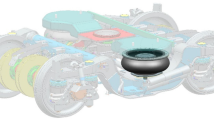Abstract
Hybrid gears made of fiber-reinforced polymeric composite material and steel are recently attracting electric vehicle designers' attention due to their possible advantages such as lightweight and reduced vibration transfer for automotive transmissions. In this study, polymeric composite material is placed in-between the steel teeth and a central hub region in the radial direction of the hybrid helical gear. The partial usage of polymeric composite material for the high torque gear is expected to reduce the transmissibility of vibration from teeth to hub as well as the weight of a transmission gear-train. Using the finite element method, optimization, and vibration tests, a composite hybrid helical gear satisfying strength and vibration characteristics is successfully developed in this study. The reduction in acceleration of the hybrid gear is observed by comparing to that of a 100 % steel gear. From a point of view in damping ratio, the composite hybrid gear can make reduction of vibration by 42.3 %. To secure the bonding strength between steel and composite parts, the design optimization for the complicated bulgy and hollow interface region is performed by considering complex dimensions.
Similar content being viewed by others
References
S. Vijayarangan and N. Ganesan, Stress analysis of composite spur gear using the finite element approach, Computers & Structures, 46 (5) (1993) 869–875.
S. Vijayarangan and N. Ganesan, Static stress analysis of a composite bevel gear using a three-dimensional finite element method, Computers & Structures, 51 (6) (1994) 771–783.
M. kurokawa, Y. Uchiyama, T. lwai and S. Nagai, Performance of plastic gear made of carbon fiber reinforced polyamide 12, Wear., 254 (5-6) (2003) 468–473.
K. Mao, A new approach for polymer composite gear design, Wear., 262 (3-4) (2007) 432–441.
S. Mahendran, K. M. Eazhil and L. S. Kumar, Design and analysis of composite spur gear, International Journal of Research and Scientific Innovation, 1 (6) (2014) 42–53.
P. B. Pawar and A. A. Utpat, Analysis of composite material spur gear under static loading condition, Materials Today: Proceedings., 2 (4-5) (2015) 2968–2974.
S. Rajeshkumar and R. Manoharan, Design and analysis of composite spur gears using finite element method, IOP Conference Series: Materials Science and Engineering, 263 (6) (2017) 62048.
C. Nitsch, B. R. Hohn, K. Stahl, M. Otto, M. Heider and F. Vogler, Prospects of compound-gears for e-mobility applications, Proc. Conf. Future Automotive Technology: Focus Electromobility, Munchen, Germany (2013) 18–19.
R. F. Handschuh, G. D. Roberts and R. R. Sinnamon, Hybrid Gear Preliminary Results—Application of Composites to Dynamic Mechanical Components, NASA/TM-2012-217630.
R. F. Handschuh, K. E. LaBerge, S. DeLuca and R. Pelagalli, Vibration and Operational Characteristics of a Composite-steel Hybrid Gear, NASA/TM-2014-216646.
M. Arefi, E. M. Bidgoli, R. Dimitri and F. Tornabene, Free vibrations of functionally graded polymer composite nanoplates reinforced with graphene nanoplatelets, Aerospace Science and Technology, 81 (2018) 108–117.
M. Arefi, E. M. Bidgoli, R. Dimitri and F. Tornabene, Nonlocal bending analysis of curved nanobeams reinforced by graphene nanoplatelets, Composite Part B: Engineering, 166 (1) (2019) 1–12.
H. Lee, C. Choi, J. Jin, M. Huh, S. Lee and K. Kang, Homogenizationbased multiscale analysis for equivalent mechanical properties of nonwoven carbon-fiber fabric composites, Journal of Mechanical Science and Technology, 33 (10) (2019) 4761–4770.
P. Gopal, L. R. Dharani and F. D. Blum, Hybrid phenolic friction composites containing aramid pulp Part 1. Enhancement of friction and wear performance, Wear, 193 (2) (1996) 199–206.
M. A. Hubbe and A. A. Koukoulas, Wet-laid nonwonwovens manufacture - chemical approaches using synthetic and cellulosic fibers, BioResources, 11 (2) (2016) 5500–5552.
B. D. Agarwal and L. J. Broutman, Analysis and Performance of Fiber Composites, John Wiley & Sons, New York, USA (1998) 137–141.
D. J. Inman, Engineering Vibration, 4th ed., Pearson, Boston, USA (2014) 72–73.
Acknowledgments
This work was supported by a grant (R&D, P0002124) from the great regional industry cooperative research program of Ministry of Trade, Industry and Energy and KIAT.
Author information
Authors and Affiliations
Corresponding author
Additional information
Recommended by Editor Seungjae Min
Enyoung Sim received her Master degree from Kyungpook National University in August 2019. She is currently an engineer of Hyundai Steel Co.
Cheol Kim's research interests include mechanics of composite materials, design optimization, noise and vibration analysis and battery electrodes. He received the Ph.D. degree from the University of Illinois at Urbana-Champaign.
Ki-seok Kwak is currently in a master degree program in the graduate school of Kyungpook National University. Bongjoon Kim is currently a director of research team in Kyungchang Co. He received the Ph.D. degree from Busan National University.
Rights and permissions
About this article
Cite this article
Sim, E., Kim, C., Kwak, KS. et al. Optimum interface shape and vibration test for a new transmission helical gear composed of steel and aramid/phenol composite. J Mech Sci Technol 34, 1629–1634 (2020). https://doi.org/10.1007/s12206-020-0325-y
Received:
Revised:
Accepted:
Published:
Issue Date:
DOI: https://doi.org/10.1007/s12206-020-0325-y




